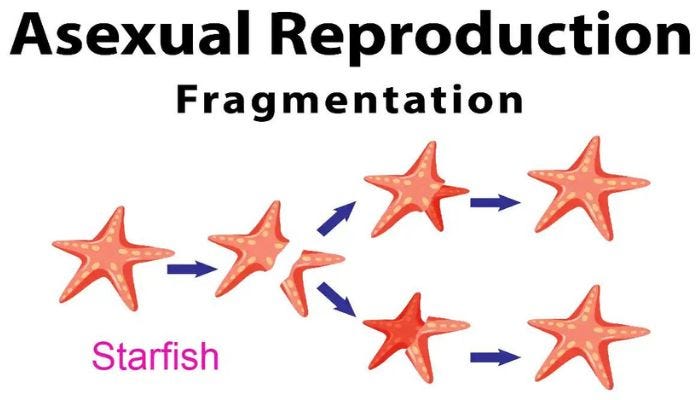
In different cell types the cell cycle can last from hours to years. E.g. bacterial cells can divide every 30 minutes under suitable conditions, skin cells divide about every 12 hours on average, liver cells every 2 years.
The mitotic phase can be sub-divided into four phases (prophase, metaphase, anaphase and telophase). Mitosis is strictly nuclear division, and is followed by cytoplasmic division, or cytokinesis, to complete cell division. The growth and synthesis phases are collectively called interphase (i.e. in between cell division). Mitosis results in two “daughter cells”, which are genetically identical to each other, and is used for growth and asexual reproduction. The details of each of these phases follows.
Cell Division by Mitosis


Asexual Reproduction
Asexual reproduction is the production of offspring from a single parent using mitosis. Therefore the offspring are genetically identical to each other and to their “parent”- i.e. they are clones. Asexual reproduction can be either natural or artificial.
| Methods of Asexual Reproduction | ||
| Natural Methods | Artificial Methods | |
| Microbes | binary fission, budding, spores, fragmentation | cell culture, fermenters |
| Plants | vegetative propagation, parthenogenesis | cuttings, grafting, tissue culture |
| Animals | budding, fragmentation, parthenogenesis | embryo splitting, somatic cell cloning |
Natural Methods


Spores. These are simply specialised cells that are released from the parent (usually in large numbers) to be dispersed. Each spore can grow into a new individual.
Vegetative Reproduction. (note also the name of an artificial technique) This term describes all the natural methods of asexual reproduction used by plants. A bud grows from a vegetative part of the plant (usually the stem) and develops into a complete new plant, which eventually becomes detached from the parent plant. There are numerous forms of vegetative reproduction, including:- bulbs (e.g. daffodil)
- rhizomes (e.g. couch grass)
- runners (e.g. strawberry)
- tubers (e.g. potato)
 Many of these methods are also perenating organs, which means they contain a food store and are used for survival over winter as well as for asexual reproduction. Since vegetative reproduction relies entirely on mitosis, all offspring are clones of the parent.Parthenogenesis. This is used by some plants (e.g. citrus fruits) and some invertebrate animals (e.g. honeybees & aphids) as an alternative to sexual reproduction. Egg cells simply develop into adult clones without being fertilised. These clones may be haploid, or the chromosomes may replicate to form diploid cells.
Many of these methods are also perenating organs, which means they contain a food store and are used for survival over winter as well as for asexual reproduction. Since vegetative reproduction relies entirely on mitosis, all offspring are clones of the parent.Parthenogenesis. This is used by some plants (e.g. citrus fruits) and some invertebrate animals (e.g. honeybees & aphids) as an alternative to sexual reproduction. Egg cells simply develop into adult clones without being fertilised. These clones may be haploid, or the chromosomes may replicate to form diploid cells.
